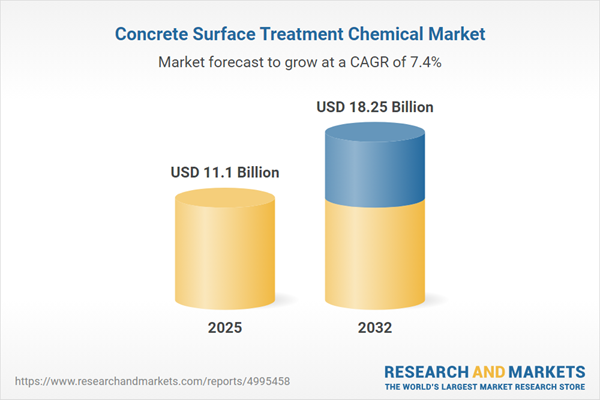Speak directly to the analyst to clarify any post sales queries you may have.
The Concrete Surface Treatment Chemical Market continues to evolve as advanced technologies reshape how decision-makers address durability, longevity, and value creation across their concrete assets. Stakeholders seek innovative solutions that answer rising performance expectations while supporting efficient operations amid shifting regulatory and supply chain demands.
Market Snapshot: Rapid Expansion in the Concrete Surface Treatment Chemical Market
The Concrete Surface Treatment Chemical Market grew from USD 10.33 billion in 2024 to USD 11.10 billion in 2025. It is expected to continue growing at a CAGR of 7.37%, reaching USD 18.25 billion by 2032.
This robust trajectory is driven by accelerating investments in infrastructure, heightened sustainability regulations, and the integration of breakthrough chemical technologies. Increased adoption in commercial, industrial, and infrastructure projects is fueling steady demand as owners and managers prioritize reliable and high-performing solutions.Scope & Segmentation: Wide Range of Applications, Products, and Regional Dynamics
- Treatment Types: Adhesives (epoxy, polyurethane), curing agents (chloride-based, silicate-based), densifiers (lithium, potassium, sodium silicates), hardeners (epoxy and polyurea), sealers (solvent-based, water-based).
- Product Forms: Liquid (water-based, solvent-based) and powder variants to suit rapid application and specific production environments.
- End Use Industries: Commercial, industrial, infrastructure, and residential projects, including those demanding stain protection, chemical and abrasion resistance, or decorative finishes.
- Application Methods: Brush roller, spray systems, and trowel pad techniques to accommodate workflows ranging from small repairs to large-scale installations.
- Regions Covered: Americas (North America, Latin America), Europe, Middle East & Africa, Asia-Pacific, with local trends shaped by regulatory, infrastructural, and climatic factors.
- Key Players Profiled: Sika AG, BASF SE, PPG Industries, RPM International, Dow, GCP Applied Technologies, MAPEI, Fosroc International, Compagnie de Saint-Gobain, The Sherwin-Williams Company.
Key Takeaways: What Senior Decision-Makers Need to Know
- Advanced chemical surface treatments are now engineered for molecular bonding to concrete, enhancing resilience against abrasion, chemicals, and environmental stressors.
- Shifts toward green chemistry are enabling compliance with broader sustainability imperatives and reducing emissions in line with global standards.
- Digital integration—including real-time monitoring—allows facility managers to proactively schedule interventions, minimizing downtime and optimizing asset life cycles.
- Strategic partnerships between raw material suppliers, technology firms, and end-users are hastening the pace of product innovation, expanding service portfolios and customization capabilities.
- Supply chain flexibility is increasingly strategic, encouraging vertical integration and regional sourcing to buffer against trade disruptions and tariff impacts.
Tariff Impact: Navigating US Policy Changes and Supply Chain Reconfiguration
Newly imposed United States tariffs on key chemical feedstocks in 2025 have driven up input costs and compelled suppliers to renegotiate contracts or diversify sourcing. This has led some manufacturers to invest in domestic production capabilities, while enhanced distributor partnerships help sustain availability and support market resilience. The result is growing emphasis on agile procurement and strategic alliances to limit disruptions and protect profitability.
Methodology & Data Sources
This analysis leverages a two-pronged research approach combining primary interviews with formulation experts, procurement leaders, and end-user engineers, alongside in-depth secondary research into academic publications, regulatory standards, patents, and industry databases. Quantitative and qualitative data undergo rigorous triangulation and peer review to ensure actionable and reliable insights.
Why This Report Matters
- Delivers detailed, segment-specific insights supporting data-driven investments in both established and emerging concrete treatment applications.
- Enables supply chain leaders to develop resilient sourcing strategies amid trade policy changes and shifting input cost landscapes.
- Equips senior executives with actionable intelligence to adjust R&D and procurement priorities for optimal portfolio differentiation and compliance.
Conclusion
The concrete surface treatment chemical sector is entering a phase of rapid innovation, regulatory alignment, and supply chain adaptation. Organizations that proactively leverage these trends and invest in performance-driven strategies will secure lasting competitive advantage as the market continues to change.
Additional Product Information:
- Purchase of this report includes 1 year online access with quarterly updates.
- This report can be updated on request. Please contact our Customer Experience team using the Ask a Question widget on our website.
Table of Contents
3. Executive Summary
4. Market Overview
7. Cumulative Impact of Artificial Intelligence 2025
Companies Mentioned
The companies profiled in this Concrete Surface Treatment Chemical market report include:- Sika AG
- BASF SE
- PPG Industries, Inc.
- RPM International Inc.
- Dow Inc.
- GCP Applied Technologies Inc.
- MAPEI S.p.A.
- Fosroc International Ltd.
- Compagnie de Saint-Gobain S.A.
- The Sherwin-Williams Company
Table Information
| Report Attribute | Details |
|---|---|
| No. of Pages | 182 |
| Published | October 2025 |
| Forecast Period | 2025 - 2032 |
| Estimated Market Value ( USD | $ 11.1 Billion |
| Forecasted Market Value ( USD | $ 18.25 Billion |
| Compound Annual Growth Rate | 7.3% |
| Regions Covered | Global |
| No. of Companies Mentioned | 11 |









